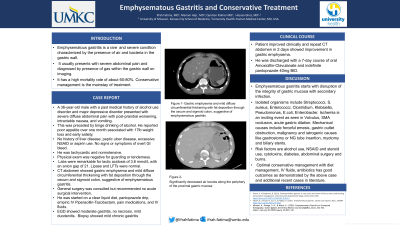Back


Poster Session E - Tuesday Afternoon
Category: Stomach
E0726 - Emphysematous Gastritis
Tuesday, October 25, 2022
3:00 PM – 5:00 PM ET
Location: Crown Ballroom

Has Audio

Ifrah Fatima, MD
University of Missouri-Kansas City
Kansas City, MO
Presenting Author(s)
Ifrah Fatima, MD1, Mariam Haji, MD2, Quinton Palmer, MD2, Hassan Ghoz, MD3
1University of Missouri-Kansas City, Kansas City, MO; 2University of Missouri, Kansas City, MO; 3University of Missouri Kansas City School of Medicine, Kansas City, MO
Introduction: Emphysematous gastritis is a rare and severe condition characterized by the presence of air and bacteria in the gastric wall. It usually presents with severe abdominal pain and diagnosed by presence of gas within the gastric wall on imaging. It has a high mortality rate of about 60-80%. Conservative management is the mainstay of treatment.
Case Description/Methods: A 36-year-old male with a past medical history of alcohol use disorder and major depressive disorder presented with severe diffuse abdominal pain with post-prandial worsening, intractable nausea, and vomiting. This was preceded by binge drinking of alcohol. He reported poor appetite over one month associated with 17lb weight loss and early satiety. No history of liver disease, peptic ulcer disease, excessive NSAID or aspirin use. He was tachycardic and normotensive. No signs or symptoms of overt GI bleeds. Physical exam was negative for guarding or tenderness. Labs were remarkable for lactic acidosis of 3.6 mmol/L with an anion gap of 21. Lipase and LFTs were normal. CT abdomen showed gastric emphysema and mild diffuse circumferential thickening with fat deposition through the cecum and sigmoid colon, suggestive of emphysematous gastritis. General surgery was consulted but recommended no acute surgical intervention. He was started on a clear liquid diet, pantoprazole drip, empiric IV Piperacillin-Tazobactam, pain medications, and IV fluids. EGD showed moderate gastritis, no necrosis, mild duodenitis. Biopsy showed mild chronic gastritis. Patient improved clinically and repeat CT abdomen in 2 days showed improvement in gastric emphysema. He was discharged with a 7-day course of oral Amoxicillin-Clavulanate and indefinite pantoprazole 40mg BID.
Discussion: Emphysematous gastritis starts with disruption of the integrity of gastric mucosa with secondary infection. Isolated organisms include Streptococci, S. Aureus Enterococci, Clostridium, Klebsiella, Pseudomonas, E.Coli, Enterobacter. Ischemia is an inciting event as seen in volvulus, SMA occlusion, acute gastric dilation. Mechanical causes include forceful emesis, gastric outlet obstruction, malignancy, and iatrogenic causes like gastrostomy or NG tube insertion, myotomy and biliary stents. Risk factors are alcohol use, NSAID and steroid use, cytotoxins, diabetes, abdominal surgery, and burns. Optimal conservative management with diet management, IV fluids, antibiotics has good outcomes as demonstrated by the above case and additional recent cases in literature.

Disclosures:
Ifrah Fatima, MD1, Mariam Haji, MD2, Quinton Palmer, MD2, Hassan Ghoz, MD3. E0726 - Emphysematous Gastritis, ACG 2022 Annual Scientific Meeting Abstracts. Charlotte, NC: American College of Gastroenterology.
1University of Missouri-Kansas City, Kansas City, MO; 2University of Missouri, Kansas City, MO; 3University of Missouri Kansas City School of Medicine, Kansas City, MO
Introduction: Emphysematous gastritis is a rare and severe condition characterized by the presence of air and bacteria in the gastric wall. It usually presents with severe abdominal pain and diagnosed by presence of gas within the gastric wall on imaging. It has a high mortality rate of about 60-80%. Conservative management is the mainstay of treatment.
Case Description/Methods: A 36-year-old male with a past medical history of alcohol use disorder and major depressive disorder presented with severe diffuse abdominal pain with post-prandial worsening, intractable nausea, and vomiting. This was preceded by binge drinking of alcohol. He reported poor appetite over one month associated with 17lb weight loss and early satiety. No history of liver disease, peptic ulcer disease, excessive NSAID or aspirin use. He was tachycardic and normotensive. No signs or symptoms of overt GI bleeds. Physical exam was negative for guarding or tenderness. Labs were remarkable for lactic acidosis of 3.6 mmol/L with an anion gap of 21. Lipase and LFTs were normal. CT abdomen showed gastric emphysema and mild diffuse circumferential thickening with fat deposition through the cecum and sigmoid colon, suggestive of emphysematous gastritis. General surgery was consulted but recommended no acute surgical intervention. He was started on a clear liquid diet, pantoprazole drip, empiric IV Piperacillin-Tazobactam, pain medications, and IV fluids. EGD showed moderate gastritis, no necrosis, mild duodenitis. Biopsy showed mild chronic gastritis. Patient improved clinically and repeat CT abdomen in 2 days showed improvement in gastric emphysema. He was discharged with a 7-day course of oral Amoxicillin-Clavulanate and indefinite pantoprazole 40mg BID.
Discussion: Emphysematous gastritis starts with disruption of the integrity of gastric mucosa with secondary infection. Isolated organisms include Streptococci, S. Aureus Enterococci, Clostridium, Klebsiella, Pseudomonas, E.Coli, Enterobacter. Ischemia is an inciting event as seen in volvulus, SMA occlusion, acute gastric dilation. Mechanical causes include forceful emesis, gastric outlet obstruction, malignancy, and iatrogenic causes like gastrostomy or NG tube insertion, myotomy and biliary stents. Risk factors are alcohol use, NSAID and steroid use, cytotoxins, diabetes, abdominal surgery, and burns. Optimal conservative management with diet management, IV fluids, antibiotics has good outcomes as demonstrated by the above case and additional recent cases in literature.

Figure: A- Gastric emphysema and mild diffuse circumferential thickening with fat deposition through the cecum and sigmoid colon, suggestive of emphysematous gastritis
B- Significantly decreased air locules along the periphery of the proximal gastric mucosa
B- Significantly decreased air locules along the periphery of the proximal gastric mucosa
Disclosures:
Ifrah Fatima indicated no relevant financial relationships.
Mariam Haji indicated no relevant financial relationships.
Quinton Palmer indicated no relevant financial relationships.
Hassan Ghoz indicated no relevant financial relationships.
Ifrah Fatima, MD1, Mariam Haji, MD2, Quinton Palmer, MD2, Hassan Ghoz, MD3. E0726 - Emphysematous Gastritis, ACG 2022 Annual Scientific Meeting Abstracts. Charlotte, NC: American College of Gastroenterology.
